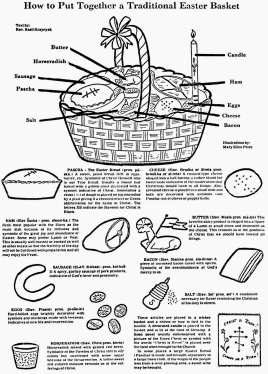UKRAINIAN CATHOLIC YOUTH & YOUNG ADULTS
Archeparchy of WinnipegPascha Basket
Pascha Basket
Avoiding Easter bunnies? Try making a Pascha Basket this year and include the following traditional foods, each with asymbolic significance!

These are: a yeast bread, a bitter herb, wine, cheese, meat, butter, salt, and a red egg. Sweet bread is always included, leavened with yeast. This is a symbol of the New Covenant; the Jews made unleavened bread, and we, the Children of the New Covenant, make leavened bread. Kulich is the traditional Russian bread, and Tsourekia is the traditional Greek braided bread. The braided form of this bread is a display of the Trinity. The bitter herb, often horseradish or garlic, serves as a reminder of the first Passover (horseradish is eaten as a traditional part of the original Passover meal) and of the bitter sufferings which Christ endured for our sake. Sometimes the herb is colored red with beets, symbolizing the Blood of Christ. The bitter herb is also to bring to mind the Jews’ forty years of wandering in the wilderness. Wine, cheese, and butter are figurative of all the good things of life, and remind us of the earthly gifts that come from God. Meat is included in remembrance of the sacrifice of the Old Testament Passover, which has been replaced by Christ, the New Passover and Lamb of God. Salt serves as a reminder to us that we are “the salt of the earth.”
The red egg is likened to the tomb from which Christ arose. This is because of the miracle of new life which comes from the egg, just as Christ miraculously came forth from the tomb.

Many Eastern Catholics also cover their basket with a Pascha basket cover.
http://www.iarelative.com/easter/bcover.htm

One of the most prized possessions in many families with roots in Eastern Europe is the Easter basket or Pascha cover.
The covers have symbols related to the Resurrection and the celebration of Easter. In many families the cover are passed on from generation to generation.
The foods traditionally blessed for Easter fall into three categories. Easter bread, also called Pascha, meat products, like ham, sausage, and bacon, and dairy products, like butter, Easter cheese, and Pysanky eggs. The covers are use to protect the contents of the baskets brought to church for blessing.
The appointed time of the blessing of the paschal foods is most often Holy Saturday or Easter morning. The Easter basket of food along with cover and candle is brought to the church. Having prepared themselves during Lent and by making their Easter confession and receiving Holy Communion, the faithful eat the blessed food on Easter Sunday and the days following Easter.
The most common element found on Easter basket covers is the Cross, the symbol of the resurrection. Pussy willows, roses, and other flowers are frequent design elements.
You will also find, angels, candles, Pysanky eggs, and Pascha bread on many basket covers.
The Pascha cover will very often carry the message of the Resurrection in the mother languge of the owner. The messages can be found in English, Slovak, Rusyn, Church Slavonic, Ukrainian and other languages of Eastern Europe.
Many times, the messages of resurrection is written in the Cyrillic letters of old as shown above and below.
For many people in America, this phrase, meaning “Christ is Risen” is the only words they can recognize in Cyrillic.
Embroidery is the most common method of decorating the Pascha basket covers. Those that practice the art of embroidery take great pride in making their covers. They realize that they are making something that will become a family heirloom.
In modern days, some Parcha covers now use silk-screenings which are quicker, easier, and less expensive to make.
The variations in designs and motifs is quite extensive. Even when at a Basket Blessing with hundreds of baskets, you will very seldom ever find two embroidered Pascha covers that are identical. Each makes a unique statement about the owners heritage and beliefs.
“Christ is risen from the dead, by death He conquered death, and to those in the graves He granted life!”
Here are some more links on Pascha Baskets.
Instructions
- Put a white candle in a straw basket. It does not have to be a straw basket of any particular size or shape. You will light the candle when the basket is blessed.
- Add a Pascha loaf to the basket. Pascha is a round, leavened loaf of white bread made with eggs, milk and raisins. It symbolizes the risen Lord and spiritual nourishment.
- Put colored, hard-boiled eggs in the basket. The eggs symbolize rebirth and they are colored because of an old belief that Mary’s tears colored the eggs.
- Press the butter into a cross or a lamb with a butter press and place it in the basket. Include a bitter herb, usually horseradish, to the basket to symbolize the bitter drink offered to Jesus on the cross.
- Put meat, usually ham, bacon or sausage, in the basket to symbolize God’s generosity and put salt in the basket to remind you that you are the salt of the earth.
- Include chocolate and candy in the basket so that children can enjoy the tradition and the things it symbolizes. Some parishes also encourage the addition of a bottle of wine.
- Cover the contents of the basket with a white cloth. Carry the basket to church on Easter morning.
- Light the candle when the priest begins the blessings of the baskets and when the other parishioners light theirs. Carry the basket home
- with you after the service.



Leave a comment